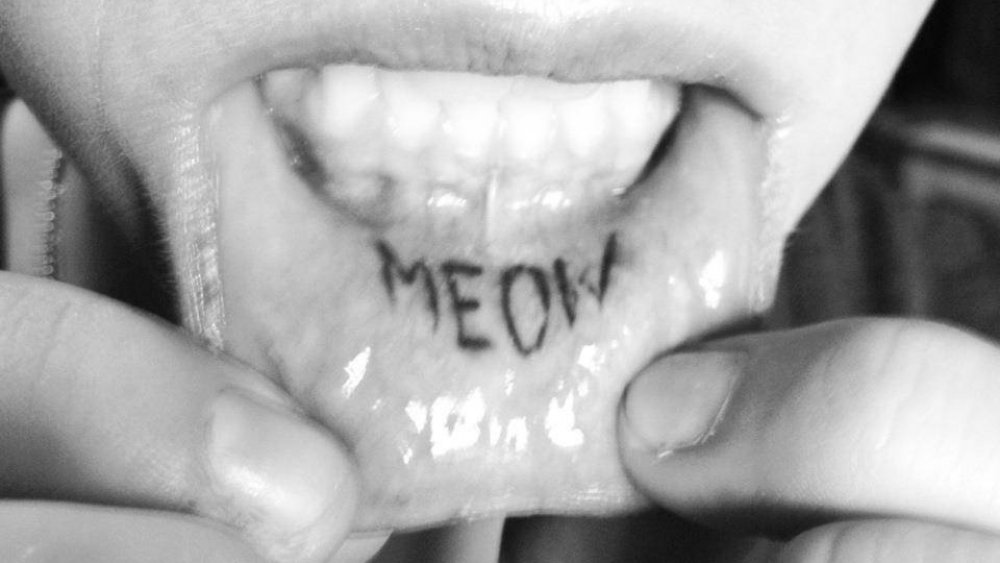Inner lip tattoos have become an increasingly popular choice for individuals seeking a unique and intimate form of body art. These tattoos, as the name suggests, are inked on the inner surface of the lips, offering a hidden yet captivating display. The allure of inner lip tattoos lies in their subtle nature, providing a personal statement that is only revealed when desired. However, the process and aftercare of such tattoos are critical to ensuring a successful and safe outcome.
The Intrigue of Inner Lip Tattoos

Inner lip tattoos have gained traction in the body art world due to their covert nature. They offer a way for individuals to express their personality and interests in a discreet manner. Whether it’s a single word, a meaningful quote, or a small symbol, these tattoos can carry deep significance for the wearer. Additionally, the element of surprise when revealing such a tattoo adds to its allure.
Choosing the Right Design
Selecting the right design for an inner lip tattoo requires careful consideration. Given the tattoo’s location, the design should be simple yet impactful. Small words, initials, or symbols often work best, as they are easier to read and less likely to distort over time. Popular choices include names, dates, inspirational words, or even small icons that hold personal meaning.
It's essential to keep in mind that the size of the tattoo is limited by the available space on the inner lip. The tattoo artist will provide guidance on the best design and placement to ensure the tattoo is comfortable and aesthetically pleasing.
| Design Type | Examples |
|---|---|
| Words/Quotes | "Carpe Diem", "Love", "Inspire" |
| Initials | A single letter or a pair of initials |
| Symbols | Heart, peace sign, star |

The Tattoo Process
The process of getting an inner lip tattoo is similar to other tattoo procedures, but it requires additional care due to the sensitive nature of the lips. Here’s a step-by-step guide:
- Consultation: Schedule a consultation with a reputable tattoo artist who has experience with inner lip tattoos. Discuss your design ideas, and they will guide you on the best approach.
- Preparation: The artist will ensure the area is clean and sanitized. You may be asked to rinse your mouth with an antiseptic mouthwash.
- Numbing: To minimize discomfort, the artist may apply a topical numbing agent to the inner lip. This helps reduce pain during the tattooing process.
- Tattooing: The artist will use a fine needle to apply the tattoo. The process is relatively quick, especially compared to larger tattoos. The artist will work carefully to ensure the design is accurate and precise.
- Aftercare: Proper aftercare is crucial for the healing process. Your artist will provide specific instructions, but general guidelines include keeping the tattoo clean, avoiding certain foods, and avoiding kissing or oral activities that could irritate the tattoo.
Healing and Aftercare

The healing process for inner lip tattoos can be more challenging compared to tattoos on other parts of the body. The lips are constantly in motion, and the healing tattoo may be sensitive to certain foods, drinks, and even oral hygiene practices.
Healing Timeline
Inner lip tattoos typically take longer to heal compared to tattoos on other areas of the body. The healing process can range from 2 to 4 weeks, and in some cases, it may take up to 6 weeks. During this time, the tattoo will go through several stages of healing, including initial swelling, scabbing, and finally, the tattoo’s colors settling.
It's important to note that the healing process can be influenced by various factors, including the individual's healing ability, the size and complexity of the tattoo, and the aftercare measures taken.
Aftercare Tips
Proper aftercare is crucial to ensure a successful healing process and minimize the risk of infection or complications. Here are some essential aftercare tips:
- Cleanliness: Keep the tattooed area clean by gently rinsing it with warm water several times a day. Avoid using soap or harsh cleansers, as they can irritate the sensitive skin.
- Avoid Irritants: Steer clear of spicy or acidic foods, as they can cause irritation and discomfort. Additionally, avoid alcohol, tobacco, and caffeine, as these can interfere with the healing process.
- No Picking: It's tempting to pick at scabs, but it's crucial to resist this urge. Picking can remove the tattoo ink and lead to scarring or infection.
- Sun Protection: Once the tattoo is fully healed, protect it from the sun's harmful UV rays. Use lip balm with SPF when outdoors to prevent fading and damage.
- Oral Hygiene: Maintain good oral hygiene practices, but be gentle. Avoid vigorous brushing or using abrasive toothpaste during the healing process.
Longevity and Fading
Like all tattoos, inner lip tattoos are subject to fading over time. The constant movement of the lips, exposure to saliva, and the natural healing process can all contribute to fading.
Factors Affecting Fading
Several factors can influence the rate and extent of fading in inner lip tattoos:
- Ink Quality: High-quality tattoo ink is less likely to fade quickly. Discuss ink options with your artist to ensure the best results.
- Healing Process: Proper healing and aftercare can help maintain the tattoo's vibrancy. Inadequate aftercare may lead to faster fading.
- Sun Exposure: UV rays from the sun can cause tattoos to fade more rapidly. As mentioned earlier, protect your tattoo with lip balm containing SPF.
- Lifestyle: Certain habits, such as smoking or frequent consumption of acidic or spicy foods, can accelerate fading.
Touch-Ups and Maintenance
To maintain the vibrancy of your inner lip tattoo, consider touch-ups. Touch-ups are recommended every few years to restore the tattoo’s original appearance. Consult with your tattoo artist to schedule touch-up sessions as needed.
Potential Risks and Complications
While inner lip tattoos can be a beautiful form of self-expression, it’s essential to be aware of the potential risks and complications associated with the procedure.
Infection
As with any tattoo, the risk of infection exists. The mouth is home to a diverse range of bacteria, so maintaining proper hygiene and following aftercare instructions is crucial to minimize this risk.
Swelling and Discomfort
Swelling and discomfort are common immediately after the tattoo is applied. The lips may feel tender and sensitive, and there may be some swelling. This is a normal part of the healing process and typically subsides within a few days.
Scarring
In rare cases, inner lip tattoos can result in scarring. This is more likely to occur if the tattoo is not cared for properly during the healing process, or if the individual has a tendency to develop keloids or hypertrophic scars.
Allergic Reactions
Allergic reactions to tattoo ink are rare but possible. If you have a history of allergies or sensitive skin, discuss this with your tattoo artist beforehand. They can guide you on the best ink options and may recommend a patch test.
Conclusion: The Allure of Inner Lip Tattoos

Inner lip tattoos offer a unique and intimate form of self-expression. While they require careful consideration and proper aftercare, the end result can be a beautiful and personal statement. By choosing a reputable artist, following their guidance, and taking care during the healing process, individuals can enjoy their inner lip tattoos for years to come.
Are inner lip tattoos painful?
+The pain tolerance for inner lip tattoos can vary from person to person. Some describe it as a slight stinging or burning sensation. Topical numbing agents can help reduce discomfort during the process.
How long does an inner lip tattoo last?
+With proper care, inner lip tattoos can last a lifetime. However, they may fade over time due to factors like sun exposure and lifestyle habits. Touch-ups can help maintain the tattoo’s appearance.
Can I talk and eat normally after getting an inner lip tattoo?
+It may take some time to adjust to talking and eating with an inner lip tattoo. The tattooed area may feel sensitive, and certain foods or drinks may cause irritation. It’s best to follow your artist’s aftercare instructions for guidance.